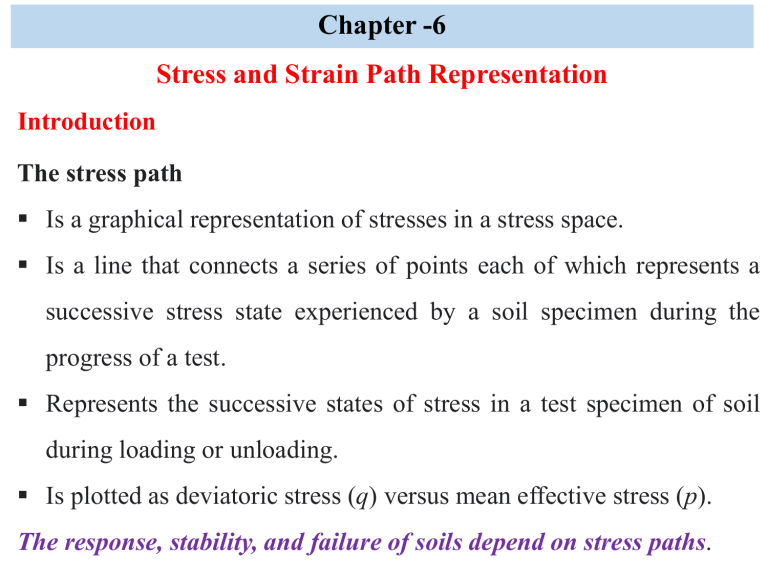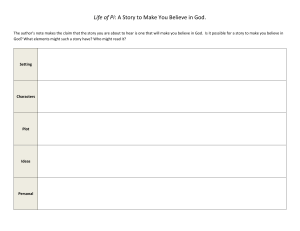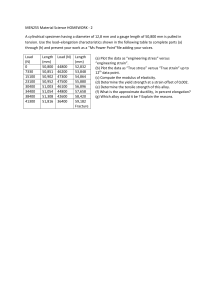
Chapter -6 Stress and Strain Path Representation Introduction The stress path ▪ Is a graphical representation of stresses in a stress space. ▪ Is a line that connects a series of points each of which represents a successive stress state experienced by a soil specimen during the progress of a test. ▪ Represents the successive states of stress in a test specimen of soil during loading or unloading. ▪ Is plotted as deviatoric stress (q) versus mean effective stress (p). The response, stability, and failure of soils depend on stress paths. 1 Stress and Strain Path Representation The stress path ▪ A series of Mohr circles can be drawn to represent the successive states of stress, but it is difficult to represent several circles in one diagram. ▪ The results of triaxial tests can be represented by diagrams called Stress paths. Successive Mohr circles 2 Stress path for constant 3 Stress and Strain Path Representation General about stress paths ▪ It is the locus of the stress point. locus; is a set of all points (commonly, a line, a line segment, a curve, or a surface), whose location satisfies or is determined by one or more specified conditions. ▪ This locus called the stress path, is plotted on what we call a p-q diagram. Note that both p and q could be defined in terms of either total stresses or effective stresses. ▪ It represents the state of stress and successive state of stress. ▪ The stress path needs to be a straight line. 3 Stress and Strain Path Representation Why do we need this stress and strain path?? ▪ An element of soil will experience changes in its state of stress or strain as the lab test progresses or is loaded in service. ▪ Sometimes it is convenient to represent that state of stress by a stress point, which has the coordinates (1 - 3)/2 and (1 + 3)/2. ▪ In geotechnical engineering, we assume 1 and 3 act on vertical and horizontal planes. ▪ So, the coordinates of the stress point are (v - h)/2 & (1 + 3)/2, or simply q and p, respectively. 4 Stress and Strain Path Representation Why do we need this stress and strain path?? ▪ Mohr circle may be employed to analyze the state of stress/strain at a particular instant during loading. ▪ We may, however, need to trace the history of the changes in the state of stress or strain. ▪ The behavior of a perfectly elastic material (loaded or unloaded within an elastic range) is independent of the route taken during the loading process. Only depends on the initial and final stress states. ▪ This is not true with soils! 5 Stress path on p and q plot ▪ Both q and p could, of course, be defined in terms of the principal stresses. ▪ By convention, q is considered positive when v > h; otherwise, it is negative. 6 Stress path on p and q plot ▪ A simple case to illustrate stress paths using the triaxial test in which 3 remains fixed as we increase 1 (45o stress path line). ▪ The initial conditions are v = h an equal-all-around or hydrostatic state of stress. Fig. 8.16 7 Stress path on p and q plot Fig. 8.17 8 Stress path on p and q plot Prove! Verify that stress paths A, B, and C of hydrostatic and A and D of nonhydrostatic compression are correct as shown. Solution: The initial conditions for all stress paths in hydrostatic compression are 9 Stress path on p and q plot 10 Stress path on p and q plot 11 Stress path on p and q plot 12 Stress ratio (K) ▪ The stress ratio is defined as the ratio of the second invariant of the deviatoric stress tensor to the first invariant of the stress tensor. ▪ It is often convenient to consider stress ratios. ▪ The lateral stress ratio K is the ratio of the effective horizontal stress to the effective vertical stress. ▪ The coefficient of lateral earth pressure at rest (Ko)for conditions of no lateral strain, or the assumed condition in the ground. ▪ Finally, we can define a ratio Kf for the stress ratio at failure: 13 Stress ratio (K) and Stress Path ▪ Usually, Kf is defined in terms of effective stresses, but it could also be expressed in terms of total stresses. ▪ Constant stress ratios appear as straight lines on a p-q diagram. 14 Stress ratio (K) and Stress Path ▪ These lines could also be stress paths for initial conditions of v = h = 0 with loadings of K equal to a constant (that is, constant v /h ). ▪ Other initial conditions are, of course, possible, such as those shown in Figs. 8.16 and 8.17. ▪ Note that:where, is the slope of the line of constant K when K < Kf. At failure, the slope of the Kf line is indicated by the symbol . 15 Stress paths for shear strength testing ▪ As a reminder, stress paths are a convenient representation of multiple Mohr circle states for a soil element undergoing any number of loading and/or unloading processes. ▪ Both q and p could be defined in terms of the principal stresses, and by convention, q is considered positive when v > h; otherwise, it is negative. ▪ We are often interested in conditions of failure, and it is useful to know the relationship between the Kf line and the Mohr-Coulomb failure envelope. 16 Stress paths for shear strength testing ▪ To establish the slopes of the two lines and their intercepts, several Mohr circles and stress paths, determined over a range of stresses, were used. ▪ The equation of the Kf line is:- 17 Stress paths for shear strength testing 18 Stress paths for shear strength testing Relationship between the K, line and the Mohr-Coulomb failure envelope The equation of the Mohr-Coulomb failure envelope is: From the geometries of the two circles, it can be shown that and So, from a p-q diagram, the shear-strength parameters and c may readily be computed. 19 Reading assignment Stress path based on Total stress path(TSP), effective stress path(ESP) for CD, CU and UU tests… Assignment 6 20

